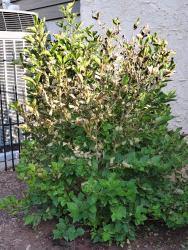I'm really finding it hard to believe that they used bleach, even the older version with sodium hypochlorite, based on my own experience. I just read my bleach bottle, and it is the older version.
My experience is that I pour, and not spray, so a bit of a difference. But to clean my Iris, and rid any potential borer activity including eggs, I use 1 part bleach (sodium hypochlorite) to 10 parts water. I use a 5-gallon tub for that, and sometimes I have two (2) tubs going. This translates to 1/2 gallon bleach to 5 gallons of water. (I do use rubber gloves.) When I'm done, that whole tub or two tubs gets poured at my burn pile. It has hurt nothing (except the earthworms). I have a Lilac Bush 6-8 feet away and it is fine. I've done this for several years. The earthworms even return to that area from season to season.

I will be interested to hear further results on this one.

